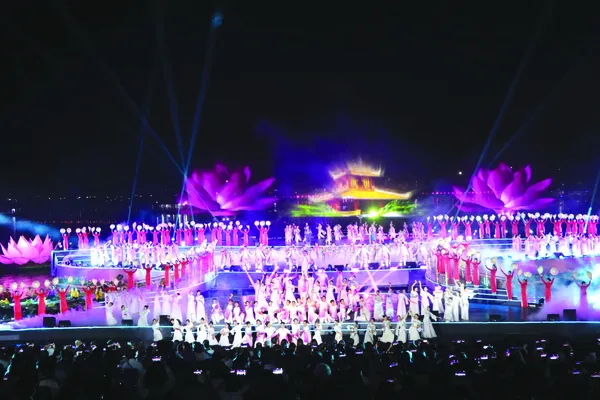 Features
Features

When we conquered Seongsang Ilcholbong Peak, this is exactly what we witnessed.
" />Jeju Island, located in the southernmost sea in Korea, is said to be abundant in rocks, wind and women.
When we conquered Seongsang Ilcholbong Peak, this is exactly what we witnessed.
 |
| Stunning crater: An aerial view of Seongsang Ilcholbong Peak. Photo visitjeju.net |
by Lương Thu Hương
Jeju Island, located in the southernmost sea in South Korea, is said to be abundant in rocks, wind and women.
When we conquered Seongsang Ilcholbong Peak, this is exactly what we witnessed.
Situated some 50km east from the centre of the island, Seongsang Ilcholbong Peak is one of the major tourist attractions on Jeju, the island with the highest number of inactive volcanoes in the world.
Seongsang Ilcholbong itself is an inactive volcano. Its peak was formed from three large volcanic eruptions some 5,000-7,000 years ago. From a distance, the peak looks like a magnificent crown of nature rising above the ocean.
One can visualise the shape of Seongsang Ilcholbong peak simply from its name. Seen from above, the periphery of the bowl-shaped crater is dotted with small peaks, like the crenulated parapets of a castle. Which is why the local people have dubbed it "Seongsan", meaning “castle mountain”.
Apart from its shape, one can also guess Seongsang Ilcholbong’s location from its name. Connected to the mainland of Jeju Island by a narrow, sandy spit, the peak lies at the island’s easternmost point, offering a spectacular view of the sunrise. As the peak is the first point on the island to greet the rising sun, it came to be called "Ilchulbong", meaning “peak of the rising sun”.
A magnificent conical-shaped natural beauty, Seongsang Ilcholbong illustrates the characteristics of a hydro volcanic eruption. The tuff cone has been protected as a UNESCO World Natural Heritage since 2007.
A land of beauty, statues and myth
To reach the summit of the peak, we had to follow a 200m-long gently-sloping stairway leading to the top. Viewed from the parking lot, the cone looks like a folding screen set against the blue sky, as if attempting to block the mighty ocean winds. Living up to its name as the most windy region in Jeju, the gusts here are fast and furious.
The higher we got, the more we realised that Seongsan Ilchulbong was a perfect spot to contemplate the stunning beauty of Jeju Island, which is surrounded by blue sea water, dotted with peaceful residential areas and covered with grass that had turned yellow in winter.
The journey to conquer Sunrise Peak became more exciting as we could enjoy the wonders of nature along the way - rocks of all shapes and sizes. These rocks have been named for their shapes, such as Deungyeongdolbawi Rock (Lamp-oil Container Rock), Chogwanbawi Rock (Military Officer Rock), Bear Rock, and Elephant Rock.
We came across numerous statues of Harubang, the deity blessing Jeju Island with protection and fertility, during our slow meditative climb. The statues were carved from volcanic rocks.With lenient smiles and large noses and bellies, these statues are found in nearly every building on the volcanic island to protect the owners against evil spirits and have become its cultural symbol. It is said that if a woman touches the nose of a Harubang statue, she will give birth to a boy.
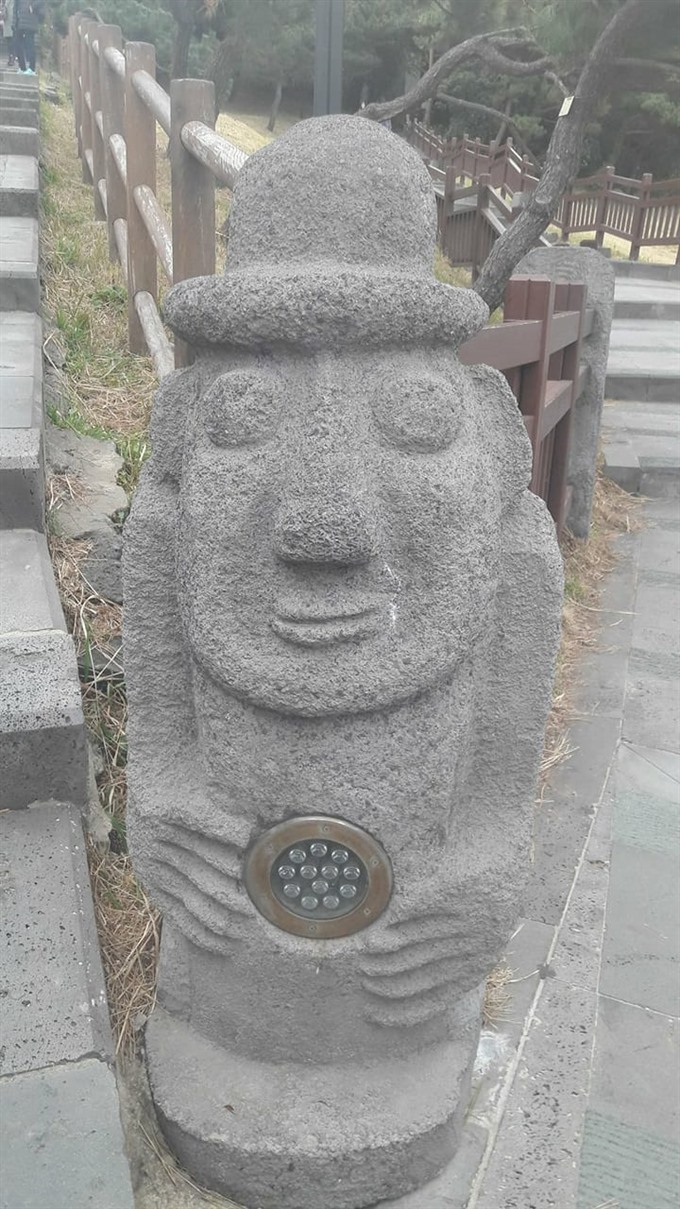 |
| Lucky symbol: Numerous statues of Harubang, the deity blessing Jeju Island with protection and fertility, are seen along the climb to Seongsang Ilcholbong Peak. VNS Photo Lương Thu Hương |
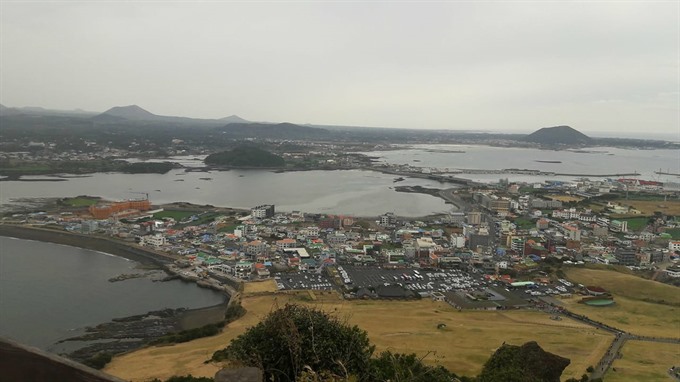 |
| Panoramic view: From Seongsang Ilcholbong Peak, tourists can have a comprehensive view of Jeju Island. VNS Photo Lương Thu Hương |
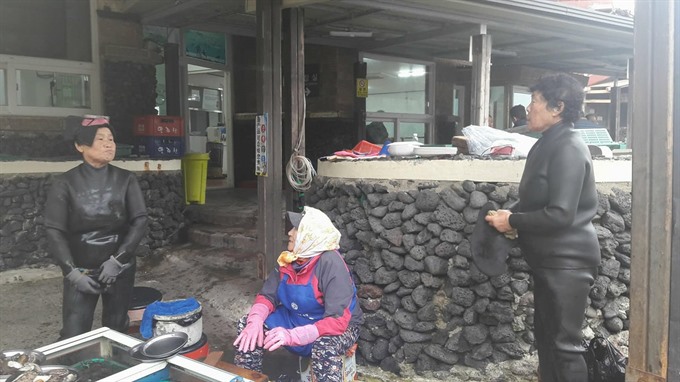 |
| Still working: Tourists might have the chance to meet Jeju’s living heritage, the female divers or haenyeo. Now there are only about 20 haenyeo left on the island, all of whom are now in their 70s and 80s but have strong figures and loud voices. VNS Photo Lương Thu Hương |
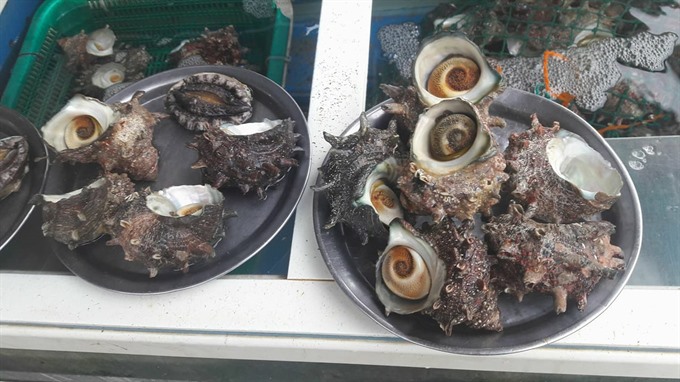 |
| Catch of the day: shellfish, such as abalone or sea urchins, are freshly caught by Jeju’s female divers and put up for sale. VNS Photo Lương Thu Hương |
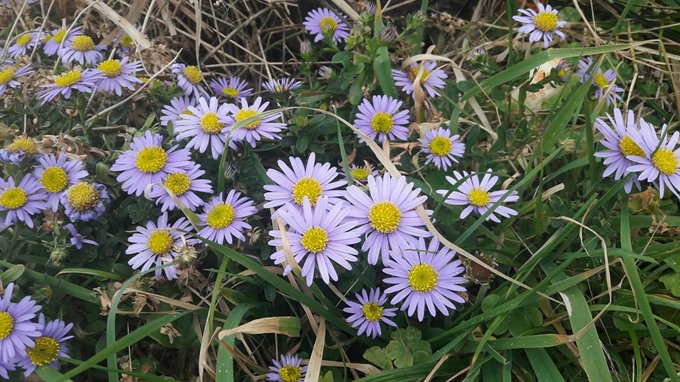 |
| In bloom: Wild daisy grows abundantly along the stairway to Seongsang Ilcholbong Peak. VNS Photo Lương Thu Hương |
Jeju’s mermaids
It took us less than an hour to scale the 90m peak. The climb is easy for anyone who exercises regularly. And the reward for conquering the peak was truly breathtaking — a picturesque view of the land below and fresh and cool gusts of wind blowing from the sea. Whatever little tiredness we felt seemed to disappear in seconds.
At the summit, only a part of the crater is open to the public. A fence has been set up for the safety of tourists and for the protection of the environment. But we managed to get a comprehensive view of the smooth bowl-shaped crater, which is now covered with green grass all year round, and the surrounding peaks. We were astonished to learn that the total area of the crater, approximately 2.6sq.km, is big enough to accommodate an entire village.
As we descended to the parking lot, we saw a rather wide stairway, which was a perfect vantage point for viewing the tuff cone. This is the photo area, where tourists have their photographs taken with the majestic tuff cone in the background.
As we were halfway down, a loud singing voice through loudspeakers caught our attention. Instead of turning left to go down, we took another track on our right. Following the voice, we reached a building called "House of Women Divers". Here, tourists can see women divers at work or listen to the songs they sing while rowing their boats.
Called haenyeo in the local language, the women divers are part of Jeju’s unique culture and have been recognised as UNESCO’s Intangible Cultural Heritage of Humanity since 2016. They can dive 10m below the sea to gather shellfish, such as abalone or sea urchins, for a living. And they do this without the help of oxygen masks and even in freezing cold weather.
As it is a tough job, fewer young women in Jeju Island have followed the practice of their ancestors. As a result, there are only about 20 women divers left in the island, all of whom are now in their 70s and 80s. We were surprised that even at this age, the women divers were strong and agile — a symbol of Jeju’s diligence and strength. However, most of them have poor hearing, a fallout of diving deep into the ocean for many years. This perhaps explains why the haenyeo talk loudly to each other as if they are having a quarrel.
In front of the House of Women Divers, we could also see the abalone and sea urchins that had been freshly caught by Jeju’s “mermaids” and were up for sale.
We clicked photographs in front of the stunning black basalt rock to keep alive our precious memories of conquering Sunrise Peak on beautiful Jeju Island. VNS




